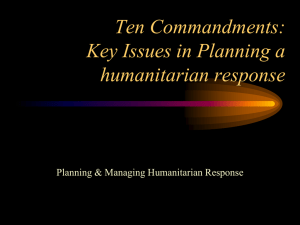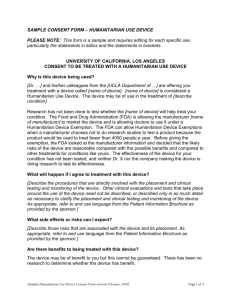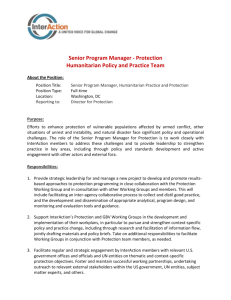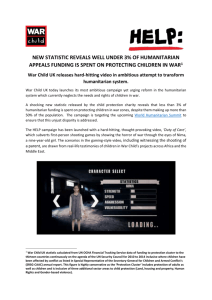NER_Faizabad - HumanitarianResponse
advertisement
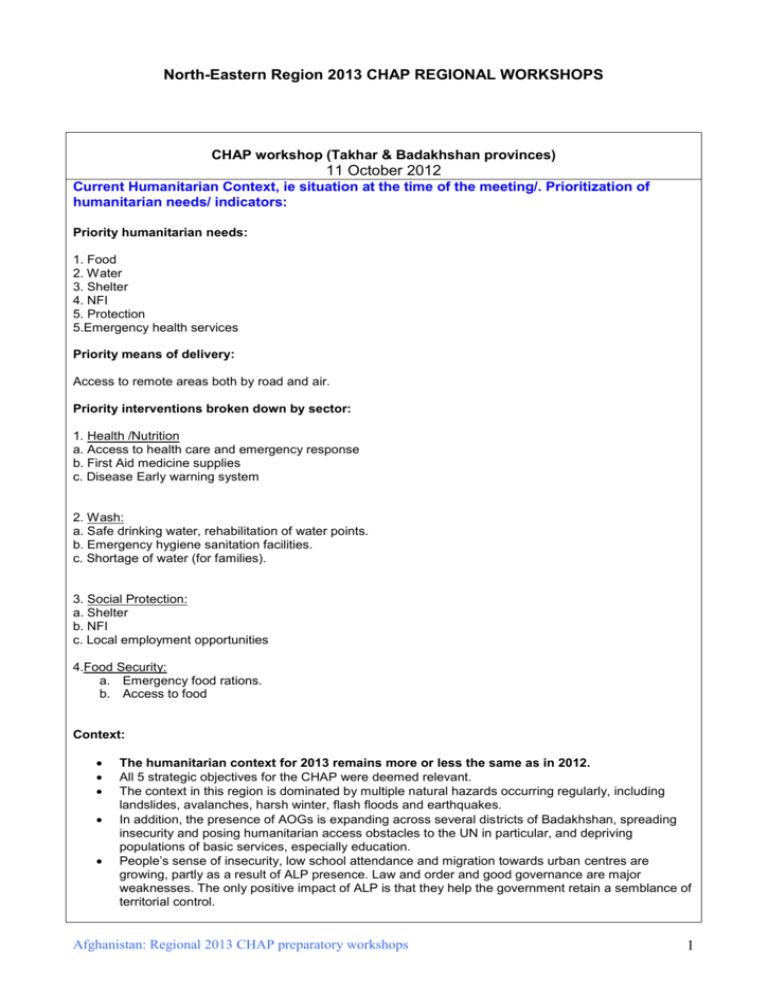
North-Eastern Region 2013 CHAP REGIONAL WORKSHOPS CHAP workshop (Takhar & Badakhshan provinces) 11 October 2012 Current Humanitarian Context, ie situation at the time of the meeting/. Prioritization of humanitarian needs/ indicators: Priority humanitarian needs: 1. Food 2. Water 3. Shelter 4. NFI 5. Protection 5.Emergency health services Priority means of delivery: Access to remote areas both by road and air. Priority interventions broken down by sector: 1. Health /Nutrition a. Access to health care and emergency response b. First Aid medicine supplies c. Disease Early warning system 2. Wash: a. Safe drinking water, rehabilitation of water points. b. Emergency hygiene sanitation facilities. c. Shortage of water (for families). 3. Social Protection: a. Shelter b. NFI c. Local employment opportunities 4.Food Security: a. Emergency food rations. b. Access to food Context: The humanitarian context for 2013 remains more or less the same as in 2012. All 5 strategic objectives for the CHAP were deemed relevant. The context in this region is dominated by multiple natural hazards occurring regularly, including landslides, avalanches, harsh winter, flash floods and earthquakes. In addition, the presence of AOGs is expanding across several districts of Badakhshan, spreading insecurity and posing humanitarian access obstacles to the UN in particular, and depriving populations of basic services, especially education. People’s sense of insecurity, low school attendance and migration towards urban centres are growing, partly as a result of ALP presence. Law and order and good governance are major weaknesses. The only positive impact of ALP is that they help the government retain a semblance of territorial control. Afghanistan: Regional 2013 CHAP preparatory workshops 1 Priority needs, natural disasters: health/nutrition, wash, social protection, food security, coordination, community capacity building. A shift from emergency relief to recovery is underway (WFP). Household distribution of relief items is a priority for emergency preparedness. Prepositioning of relief items at district centres does not reach communities in need. Priority needs, conflict: Food/water, shelter/NFI, protection, emergency health services. Priority group of beneficiaries: IDPs. Thresholds for response: The regional workshop mostly agreed with national CHAP workshop suggestions. Response to small-scale disasters should be reserved for national government counterparts. Humanitarian response should only be triggered when lives are endangered. Context Elements: List key elements of the humanitarian context and factors that influence this. Remember to address both conflict and natural disaster. It will be more/less the same as 2012. Considering difficult terrain especially in Badakhshan there is urgent need for air transportation assets. Identification of areas for prepositioning of stockpiles (possible/safe) mainly in highly vulnerable locations. For all sectors of response, funding is expected to decline. This is forcing humanitarian actors to scale down their operations, as is already happening with WFP. There is a strong need to focus on resilience interventions in the region. Building flood barriers is a good emergency preparedness activity but nobody funds it. Conflict: Humanitarian actors fear the security consequences of PRT drawdown next month. The expected consequences include: - UNAMA will be first port of call for spontaneous demonstrations. - There will be no force to call on in conflict situations. Security incidents are on the rise. They impact humanitarian actors in different ways. NNGOs continue operations regardless. INGOs suspend operations temporarily, while the UN suspends long term. In light of deteriorating security, there is a strong need to develop the capacity of NNGOs so that they in time can replace the INGOs. Project design should include remote management, to enable project continuation with national/local capacity when internationals are forced to withdraw for security reasons. Disaster: Deforestation - due i.a. to collection of all vegetation for selling as firewood - causes increased occurrence of floods. Deforestation also happens as a result of overgrazing. People rely too much on livestock income because agriculture has failed. The best kind of response is education. The impact of hazards is high because of poor physical access in the winter to districts/villages beyond district centres, and poor telecommunications which means that affected populations cannot easily inform the outside world of avalanches or health emergencies. Training at community level on emergency preparedness and response is considered the most effective action. Current Caseload: Takhar and Badakhshan provinces are highly prone to natural disasters such as avalanche, earthquake, flash floods , floods (snow melting , river overflow , rainfalls), landslide, harsh winter and associated respiratory diseases. Based on reports confirmed by ANDMA and humanitarian actors: 1- In 2012, 2700 families (16200 individuals) were affected by natural disasters in Badakshan. 2- In 2012, Takhar province was affected mostly by floods and river floods. 5341 families (32046 individuals) were affected by river overflow and flash floods resulting from snow melting and winter rainfalls. 3- In 2012, 28 families were displaced by conflict (23 families Badakshan, 5 in Takhar). The following number of affected families have been responded to: Takhar; 5102 families by NFI (831. Gaps/not responded). Afghanistan: Regional 2013 CHAP preparatory workshops 2 2200 families by Shelter (631. Gaps/not responded). 4484 families by Food (1036. Gaps/not responded). Badakshan; 2513 families by NFI (138.Gaps/not responded). 1391 Families by Shelter (76.Gaps/not responded) 1298 families by Food (650.Gaps/not responded) Most Likely Scenario. ie: what the humanitarian community believes WILL happen over the next twelve months. This scenario normally forms the basis for humanitarian planning, especially within the CHAP framework where applicable. Government control: Unlike the prediction at national level, in Badakshan and Takhar provinces the government will retain 90% formal territorial control. The community does not support AOGs. Access: NNGOs have 100% access, although security incidents do occur. Dilemma: International NGOs have better access to donors and funds, while national NGOs have better access to communities in need. Security: Security incidents and criminality are expected to rise. Perception of the UN: Expected to remain very good in both provinces. Population movements: People will try to leave the country (the well off) or to move to urban areas in order to gain employment and access to basic services. Scenario elements: Indicate probable developments, and events that might trigger these, for the next twelve months. Socio-economic, political, security, health, natural (chronic/sudden onset) elements should all be taken into account. Indicate sub-regional/cross border implications where applicable and remember the potential impact of external events. The expected incidence of natural disasters in 2013 will remain roughly the same as in 2012, see below table. Natural Disaster Floods Avalanches Number of the people will be affected Takhar Badakhshan 5000 500 10 500 Afghanistan: Regional 2013 CHAP preparatory workshops 3 Harsh Winter Earthquake Conflict Landslide Diseases out break 163 40 50 200 50 20 20 100 1200 50 Priority interventions: 1-Emergency communication. 2- Effective coordination. 3- Logistic response capacity. 4- Community based response/coordination/action communities. 5- Community capacity building on DRR. 6- Airs Transportation in 7 districts of Badakhshan province. Rationale for the Scenario/Early Warning Indicators: show for each element of the scenario why the HRT believes this element is possible, how (and by whom) developments are being monitored and which indicators are being used. Indicators; 1- Through effective coordination, humanitarian actors will be kept updated with the humanitarian situation and impact of manmade and natural disasters. 2- Improved communication will produce better information sharing within the humanitarian community. The provincial teams are able to conduct assessments and to provide accurate reports of the events. 3. Humanitarian Aid prepositioned in limited access areas. Agencies with field presence respond more effectively to populations affected by disasters. 4. Early warning system Mitigation and CBDRM project will be applied in the disaster prone areas, the rescue team established, enabling lifesaving interventions towards trapped populations. Priority interventions: 1- Effective coordination. 2- Strengthening the communication for conducting assessment, accurate and proper reporting. 3- Prepositioning the humanitarian aid, especially in the areas where are impassable for the winter. 4- Early Warning system. 5- Strengthening the critical facilities in limited access areas. Anticipated Caseload: Who will be affected by the developments and how? What impact will this have on caseload figures (increase/decrease) and what are the projected new figures in each category. Security: At the start of 2012 there were security constraints only in one district of Afghanistan: Regional 2013 CHAP preparatory workshops 4 Badakhshan and one district of Takhar, but recently the number of insecure areas has increased to 5 in Badakhshan and 3 in Takhar. In the most likely scenario, the security situation in some parts of Takhar and Badakhshan will deteriorate, and the number of conflict affected populations and IDPs will increase. Worst Case Scenario: ie what is POSSIBLE, even if it may seem UNLIKELY, in the next twelve months given the current humanitarian context. Try and think of the worst case and its consequences as this is what will really allow us to assess preparedness. Sometimes the worst case does happen . . . PRT withdrawal will lead to more warlordism AOG leadership will have a more foreign profile Perceptions of NGOs will deteriorate More unemployment will garner more popular support to AOGs HR violations, especially against women, will increase Attacks on food aid convoys will increase Better access in the region to electronic media will lead to more spontaneous and aggressive demonstrations triggered by events in the West Abduction of aid workers will increase. Scenario elements: Indicate possible developments, and events that might trigger these, for the next twelve months. Socio-economic, political, security, health, natural (chronic/sudden onset) elements should all be taken into account. Indicate sub-regional/national implications where applicable and remember the potential impact of external events. The kind of natural hazard events which would trigger the worst case scenario are: 1. Harsh winter (heavy snowfall and rainfall). 2. River overflows which derive from harsh winter. 3. Flash floods. The conflict trends that would trigger the worst case scenario are: Due to access constraints / insecurity some sectors will not be able to implement their planned activities. The AOG become stronger, more united and more influential. Priority interventions: Applying mitigation and DRR programs, especially in the 7 border districts of Badakhshan and 3 districts of Takhar province. WASH. Road rehabilitation. Afghanistan: Regional 2013 CHAP preparatory workshops 5 Air Access. Rationale for Scenario/Early Warning Indicators: show for each element of the scenario why the HRT believes this element is possible, how (and by whom) developments are being monitored and which indicators are being used. Anticipated Caseload: Who will be affected by the developments and how? What impact will this have on caseload figures (increase/decrease) and what are the projected new figures in each category. Humanitarian Consequences/ Impact of Scenario Capacity for provincial/ regional sectoral response Constraints for response Indicate only key areas in which scenario may have humanitarian implications, ie: on humanitarian access, on resources (financial/human) or on overall cluster/ sectors needs. Indicate whether there are plans, mechanisms, or resources are in place to address the consequences, or whether these need to be developed and/or there are major constraints. Please indicate major constraints Discussions and feedback on the 2013 strategic objective outline. Discussions to include relevance and appropriateness of the strategic objectives to the shared needs analysis and the appropriate thresholds that distinguish between a humanitarian and a development intervention. Reference can be made to the national level cluster recommendations / validation done on each cluster recommendation. Shelter/NFI WG Relevant to strategic Thresholds for response Responding to the shelter objectives 1,2,3 FSAC Relevant to objectives 2,4 Health/nutrition Relevant to objectives 1,2,3,5 WASH Relevant to objectives 1,2,3 Education HR, gender and mine awareness plus evacuation training in schools Afghanistan: Regional 2013 CHAP preparatory workshops requirements based on needs, such as building shelters and distribution of tents. Emergency food rations. Access to food. Provide medical services in emergencies. Access to healthy water especially for those families whose water resources are destroyed 6 by floods. Afghanistan: Regional 2013 CHAP preparatory workshops 7 General Observations/ Comments The workshop brought together a good mix of NGOs (international and national) and UN agencies from the two provinces. Local NGOs were not present, which is a minus. This was the first time humanitarian actors were brought together in strategic planning discussion at Fayzabad level. Participants therefore had little experience from previous CAP workshops. The opportunity to strategize together was well received. It was very hard to get to grips with caseloads, as each organisation operates with individual caseloads and figures are not aggregated. Drawing on the results from the national CHAP workshop was helpful for guiding the discussion on CHAP strategic objectives as well as indicators and thresholds for response. On thresholds for response, little was generated beyond the national workshop proposals; but those thresholds were verified. There was considerable interest in the introduction of resilience as a strategic humanitarian objective, but uncertainty on the boundary between humanitarian and development interventions in this regard, and fear that donors would reject resilience type interventions as part of humanitarian strategy and action. The workshop unfortunately did not capture indicators in a meaningful way. There was good understanding of the need for humanitarian actors in the region to draw on the CHAP when developing proposals. There was a strong call for support / training by OCHA in project proposal writing, especially targeting NNGOs. It will be important to capture the specificities of Badakhshan and Takher in the CHAP, especially the unique exposure to natural disasters combined with the geographical access constraints. Afghanistan: Regional 2013 CHAP preparatory workshops 8


